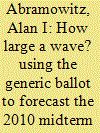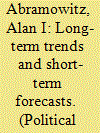| Srl | Item |
| 1 |
ID:
105417


|
|
|
|
|
| Publication |
2011.
|
| Summary/Abstract |
An examination of the results of the recent midterm elections indicates that the new House of Representatives will probably be the most conservative and ideologically polarized House since the end of World War II. Republicans will hold 242 seats after a net gain of 63 seats, constituting the largest Republican majority in the House of Representatives since the 80th Congress (1947-49), which also had 242 Republican members.
|
|
|
|
|
|
|
|
|
|
|
|
|
|
|
|
| 2 |
ID:
134790


|
|
|
|
|
| Summary/Abstract |
This article presents forecasts of national seat swing in the 2014 House and Senate elections based on relatively simple models that incorporate the results of the generic ballot question. The generic ballot question, which has been asked by the Gallup Poll since 1946 and by many other national polls in recent years, provides a way of assessing the mood of the American public in the months leading up to a national election. This question asks a national sample of American voters whether they prefer a Democrat or a Republican for the House of Representatives without providing the names of the candidates.
|
|
|
|
|
|
|
|
|
|
|
|
|
|
|
|
| 3 |
ID:
100776


|
|
|
|
|
| Publication |
2010.
|
| Summary/Abstract |
As Election Day approaches, many political commentators are asking whether the 2010 midterm elections could be a reprise of 1994, when Republicans picked up eight seats in the Senate and 52 seats in the House of Representatives to take control of both chambers for the first time in 40 years. There is almost universal agreement that Republicans are poised to make major gains in both the House and the Senate. And while the GOP's chances of gaining the 10 seats needed to take control of the upper chamber appear remote, results from the generic ballot forecasting model indicate that the 39 seats required to take back the House of Representatives are well within reach.
|
|
|
|
|
|
|
|
|
|
|
|
|
|
|
|
| 4 |
ID:
177216


|
|
|
| 5 |
ID:
131648


|
|
|
| 6 |
ID:
189577


|
|
|
|
|
| Summary/Abstract |
ALAN I. ABRAMOWITZ presents evidence from American National Election Studies surveys showing that party identification, ideological identification and issue positions have become much more closely connected over the past half century. He argues that as a result, the ideological divide between Democratic and Republican identifiers has widened considerably. The rise of partisan-ideological consistency has contributed to growing affective polarization as well as increasing party loyalty and straight ticket voting.
|
|
|
|
|
|
|
|
|
|
|
|
|
|
|
|
| 7 |
ID:
153789


|
|
|
| 8 |
ID:
090223


|
|
|
|
|
| Publication |
2009.
|
| Summary/Abstract |
The Time-for-Change Model proved one of the most accurate of the 2008 presidential election forecasts run in the October PS symposium. Using three predictors-the president's approval rating at mid-year, the growth rate of real GDP during the second quarter, and the time-for-change dummy variable-the model predicted that Barack Obama would win the presidential election with 54.3% of the major-party vote. According to nearly final tabulations compiled by uselections.org, as of December 8, Obama has received just over 53.6% of the major-party vote. However, it is likely that Obama's final total will reach 53.7% of the major-party vote. Therefore, the model's current error of 0.9 percentage points is likely to decrease further. The model has now correctly predicted the winner of the popular vote in all six presidential elections since its creation in 1988.
|
|
|
|
|
|
|
|
|
|
|
|
|
|
|
|
| 9 |
ID:
149325


|
|
|